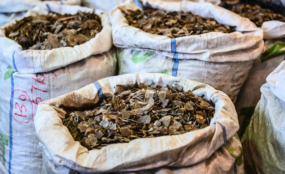Food is rarely thought of as commodity susceptible to crime. We are often re-assured by branding and supermarkets that what we purchase is what is written on the label and it is derived from safe and regulated sources. Indeed until recently, criminality and food was thought to mostly relate to the theft of high value goods such as caviar and alcoholic drinks. However, recent high profile events in Europe relating to the substitution of horse meat for beef has exposed a whole raft of illegal activity linked to food.
We now realise that food crime encompasses everything from counterfeiting to mis-representation and product substitution. Indeed it has been reported in the press that up to 10% of food purchased in the UK could be not quite as consumers think it is – and a recent cartoon in the NY Times similarly highlighted the adulteration of olive oil in the global market. So what drives this activity? Quite simply a low risk of detection and high financial gain make it appealing. Additionally, the very nature of food which as a degradable and edible commodity makes food crime detection harder than say drug dealing and the law enforcement penalties are much lower. Given the transient nature of food it is often difficult to gauge the extent of the issue, although it is well established both India and China have had substantial problems with fake food.
Perhaps the most common food crime is substitution. Whereby a product is deliberately mis-labelled or mis-represented to usually gain a financial advantage or to circumnavigate trade restrictions. In a major joint operation this month, EURPOL and INTERPOL seized more than 1000 tonnes of fake food across 33 countries, with products ranging from cereal, to spices, to honey. One of the most common frauds relates to organic produce. The premium which organic attracts makes substitution attractive and the lack of easily discernible visual differences makes it a hard fraud to detect. Common substitutions involve core basic products such as eggs and vegetables and often seek to mask true providence or quality grade. Processed food and drink is not immune with fake branding and packaging affecting diverse products such as chocolate, balsamic vinegar and champagne. While this may seem an innocuous crime, these fake products are often produced in unsanitary conditions and can expose the consumer to a variety of health risks. Other substitutions are made not so much to fool the consumer as to defraud the port authorities.
While product substitution and mis-representation is clearly fraudulent it is not the only method by which the consumer is exposed to a variety of chemicals and biological risks. Adulteration is seen in a number of forms – but its principal aim is to make a product go further or look better than it naturally is. The 2008 adulteration of baby milk powder in China is probably the most infamous- in which melamine was added to formula feed to mislead protein analysis with devastating results. Other adulterations with potentially harmful outcomes have included watering down UHT milk with contaminated tap water and adding skimmed milk powder to mask its lack of protein and introducing ground peanuts to flour to boost its weight and nutritional value. Banned dyes have also been found to have been employed to enhance the visual appearance of various products especially spices.
Counterfeit foods and ingredients are often hard to spot. Authorities rely on intelligence to identify the organised criminal gangs who trade in these goods but typically it is health related issues which first bring this crime to notice. The impacts of fake food go beyond the health issues though and can bring large-scale economic losses – not just to the retailers of the fake food but to brand holders and others in the sector who are tainted by the association. As the global recession continues to bite, the incentive to adulterate and substitute products to reduce cost is still there while the involvement of organised crime ensures widespread distribution and availability of both the products and precursors.
¿Cómo identificar un huevo podrido? La creciente tendencia en los delitos alimentarios
Raramente se asocia a la comida con el delito. Las marcas y los supermercados usualmente nos aseguran que lo que estamos comprando es lo que está escrito en la etiqueta y que proviene de fuentes seguras y reguladas. De hecho, hasta hace poco tiempo, se pensaba que la delincuencia y la comida se relacionaban principalmente con el robo de productos de alto valor, como el caviar y las bebidas alcohólicas. No obstante, algunos escándalos recientes en Europa asociados con la sustitución de carne de res por carne de caballo han expuesto una serie de actividades ilícitas ligadas a la comida.
Ahora entendemos que el delito alimentario abarca todo lo que va desde la imitación hasta la tergiversación y sustitución de un producto. Los medios han informado que hasta un 10% de la comida comprada en el Reino Unido puede no ser lo que los consumidores creen que es –una caricatura publicada recientemente en el NY Times resalta de manera similar la adulteración de aceite de oliva en el mercado global. ¿Qué impulsa, entonces, esta actividad? Sencillamente, el atractivo está en que no es fácil de detectar y es altamente redituable. Además, la misma naturaleza de la comida como materia prima degradable y comestible hace que detectar un delito alimentario sea más difícil que otro tipo de delitos, como el narcotráfico por ejemplo, y las penas aplicadas son mucho menores. Dada la naturaleza transitoria de la comida, generalmente es difícil medir la magnitud de este asunto, aunque es bien sabido que tanto India como China han tenido problemas importantes con la adulteración de la comida.
Tal vez el delito alimentario más común es la sustitución, mediante la cual un producto es deliberadamente tergiversado o mal etiquetado con el objetivo generalmente de ganar ventaja económica o circunnavegar restricciones sobre su comercialización. En una importante operación conjunta este mes, EUROPOL e INTERPOL decomisaron más de 100 toneladas de comida adulterada en 33 países, con productos que iban desde cereales hasta especias y miel. Uno de los fraudes más comunes está ligado a la producción orgánica. La recarga en el precio que tienen los productos Premium hace que la sustitución sea más atractiva; sumado a ello, la falta de diferencias visuales discernibles hace que el fraude sea difícil de detectar. La sustitución se realiza en productos básicos como huevos o vegetales, y normalmente intenta enmascarar su verdadero origen y su nivel de calidad. Bebidas y alimentos procesados no son inmunes, la falsificación de las marcas o el packaging afectan a diversos productos como chocolates, vinagres y champañas. Mientras que este puede parecer un delito inofensivo, estos productos falsos son a menudo producidos en malas condiciones higiénicas y pueden exponer al consumidor a varios problemas de salud. Otras sustituciones se realizan no tanto para engañar al consumidor sino a las autoridades portuarias.
Si bien la sustitución y tergiversación de productos es claramente una actividad fraudulenta, no es el único método por el cual el consumidor puede estar expuesto a una variedad de riesgos químicos y biológicos. La adulteración se observa en un número de formas, pero su objetivo principal es hacer que un producto siga su curso o se vea mejor de lo que naturalmente es. El caso de la adulteración de leche para bebés en China en el año 2008, en el cual se supo que se le agregaba melanina a la fórmula para confundir los análisis de proteína, es probablemente el más infame, con resultados devastadores. Otras adulteraciones con resultados potencialmente peligrosos incluyen la dilución de leche ultra pasteurizada con agua del grifo contaminada, enmascarando su falta de proteínas con leche en polvo descremada, y el agregado de cacahuates a la harina para aumentar su peso y valor nutricional. También se han encontrado colorantes prohibidos para embellecer la apariencia de algunos productos, especialmente especias.
La comida y los ingredientes adulterados usualmente son difíciles de detectar. Las autoridades dependen de operaciones de inteligencia para identificar a las bandas criminales que comercializan estos productos, pero generalmente son los asuntos relacionados a la salud los que primero hacen conocer el problema. De todos modos, el impacto de la comida tergiversada va más allá de la salud y puede acarrear pérdidas económicas de gran escala –no sólo para los vendedores finales sino para los dueños de las marcas y otros individuos que trabajan en el sector y ven manchada su reputación por mera asociación. Mientras la recesión global sigue golpeando, los incentivos para adulterar y sustituir productos para reducir costos siguen vigentes, y la participación de la delincuencia organizada garantiza la amplia distribución y disponibilidad tanto de los productos como de los precursores.



